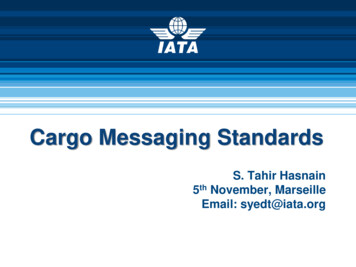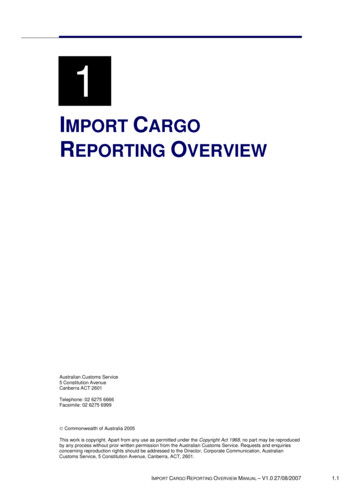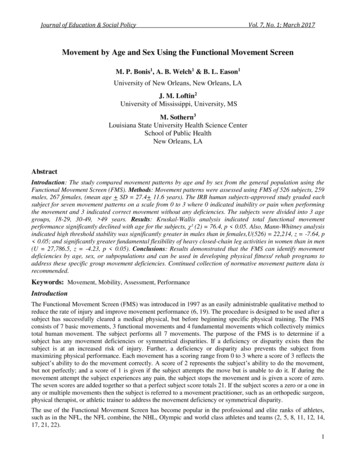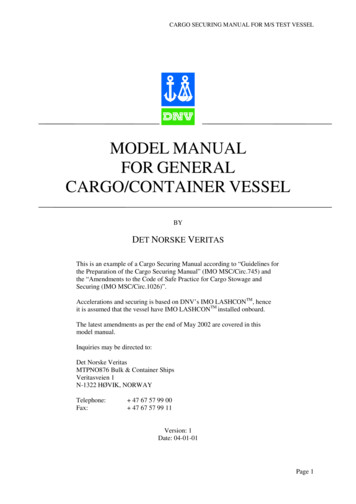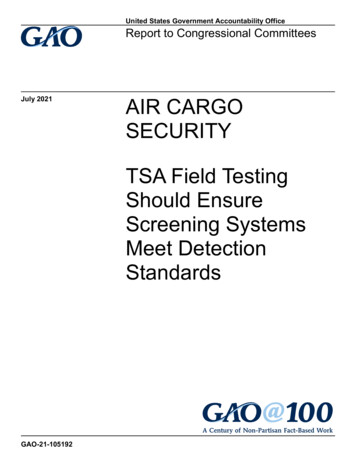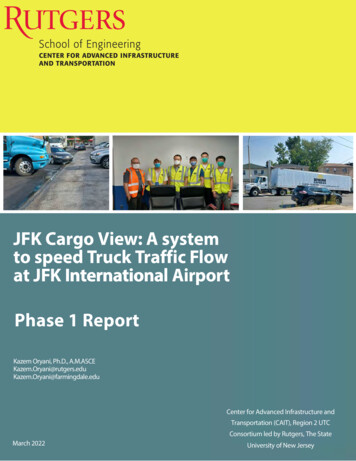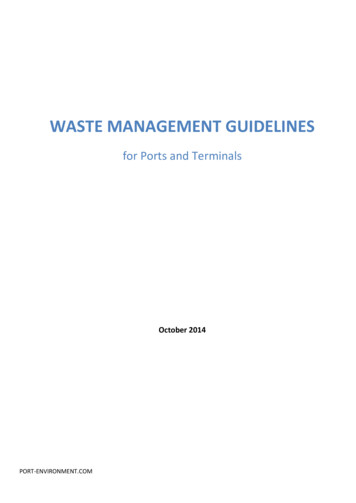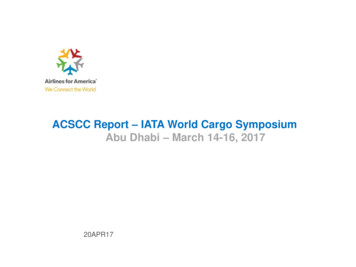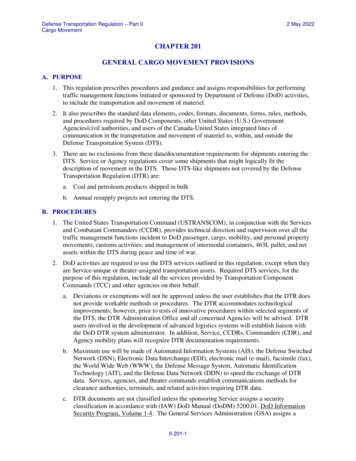
Transcription
Defense Transportation Regulation – Part IICargo Movement2 May 2022CHAPTER 201GENERAL CARGO MOVEMENT PROVISIONSA. PURPOSE1. This regulation prescribes procedures and guidance and assigns responsibilities for performingtraffic management functions initiated or sponsored by Department of Defense (DoD) activities,to include the transportation and movement of materiel.2. It also prescribes the standard data elements, codes, formats, documents, forms, rules, methods,and procedures required by DoD Components, other United States (U.S.) GovernmentAgencies/civil authorities, and users of the Canada-United States integrated lines ofcommunication in the transportation and movement of materiel to, within, and outside theDefense Transportation System (DTS).3. There are no exclusions from these data/documentation requirements for shipments entering theDTS. Service or Agency regulations cover some shipments that might logically fit thedescription of movement in the DTS. Those DTS-like shipments not covered by the DefenseTransportation Regulation (DTR) are:a. Coal and petroleum products shipped in bulkb. Annual resupply projects not entering the DTS.B. PROCEDURES1. The United States Transportation Command (USTRANSCOM), in conjunction with the Servicesand Combatant Commanders (CCDR), provides technical direction and supervision over all thetraffic management functions incident to DoD passenger, cargo, mobility, and personal propertymovements; customs activities; and management of intermodal containers, 463L pallet, and netassets within the DTS during peace and time of war.2. DoD activities are required to use the DTS services outlined in this regulation, except when theyare Service-unique or theater-assigned transportation assets. Required DTS services, for thepurpose of this regulation, include all the services provided by Transportation ComponentCommands (TCC) and other agencies on their behalf.a. Deviations or exemptions will not be approved unless the user establishes that the DTR doesnot provide workable methods or procedures. The DTR accommodates technologicalimprovements; however, prior to tests of innovative procedures within selected segments ofthe DTS, the DTR Administration Office and all concerned Agencies will be advised. DTRusers involved in the development of advanced logistics systems will establish liaison withthe DoD DTR system administrator. In addition, Service, CCDRs, Commanders (CDR), andAgency mobility plans will recognize DTR documentation requirements.b. Maximum use will be made of Automated Information Systems (AIS), the Defense SwitchedNetwork (DSN), Electronic Data Interchange (EDI), electronic mail (e-mail), facsimile (fax),the World Wide Web (WWW), the Defense Message System, Automatic IdentificationTechnology (AIT), and the Defense Data Network (DDN) to speed the exchange of DTRdata. Services, agencies, and theater commands establish communications methods forclearance authorities, terminals, and related activities requiring DTR data.c. DTR documents are not classified unless the sponsoring Service assigns a securityclassification in accordance with (IAW) DoD Manual (DoDM) 5200.01, DoD InformationSecurity Program, Volume 1-4. The General Services Administration (GSA) assigns aII-201-1
Defense Transportation Regulation – Part IICargo Movement2 May 2022security classification IAW Office of the Administrator Publication 1025.2D, HB, ClassifiedNational Security Information. When so classified, the integrity of the classification isprotected within the DTS. Classified cargo will be moved IAW procedures in Chapter 205.C. DTR PROGRAM ADMINISTRATION1. To streamline the process for making changes to this regulation, the coordination and publicationof changes to DTR 4500.9-R, The Defense Transportation Regulation, are accomplished IAWDoD Directive 4500.09, Transportation and Traffic Management.2. DTR Action Officer (AO) Working Group members will submit proposed changes via e-mailafter coordination through their Service channels, as applicable, to the USTRANSCOM DTRadministrator using a Comment Resolution Matrix (CRM). The body of the e-mail will contain:a. Subject: Include DTR part number.b. Issue: Explain the issue in detail.c. Systems Impact/Resource Implications: Identify the known impacts on automated systemsand interfaces, whether additional funding will be required to support systems changes, andthe estimated timeline for implementation of systems changes. Identify any other knownresource costs associated with the proposed change.d. As described in the instructions included in the CRM, the proposed wording for theregulation will appear in the “comment” block and the “rationale” will include knownadvantages and disadvantages of the proposed change.3. The DoD DTR administrator is responsible for staffing proposed changes via e-mail. Proposedchanges will be submitted to the USTRANSCOM DTR point of contact via e-mail, utilizing theformat identified in Paragraph C.2, above.a. Unless the proposed change is of a critical, time-sensitive nature, the proposed change will beheld until the next anticipated update for that specific part of the DTR.b. Upon approval, formal changes will be released in one of three different formats: acompletely revised/reissued publication, an interim update, or an “expedited change.” Thecoordination process is the same for revised/reissued publications and interim updates and isaddressed in Paragraph C.3.c, below. Expedited changes are addressed in Paragraph C.3.d.c. AO group members will be notified by e-mail of a proposed change package. E-mail willprovide a link to the coordination website established exclusively for staffing the proposedchange. The AO group members will be able to access all files required for reviewing theproposed changes to include comment matrices. AO group members will have 45 calendardays to respond to the proposed change package. If an individual Service/Agency AO groupmember feels the proposed change package requires internal coordination within his or herService/Agency or with a field activity, the individual may perform the coordination,provided the additional input is consolidated into a single Service/Agency response. The 45calendar day window should be adhered to in order to expedite the change process. WhenAO coordination has been obtained, this process will be essentially repeated with theOversight Working Group utilizing a 30-calendar day window. Upon approval,USTRANSCOM will publish the change.d. If a proposed change is critical or time-sensitive, it may be coordinated as an “expedited”change at the AO and then the Oversight Working Group levels, as outlined above. Unlike aformal change, an expedited change will typically address only one specific issue (e.g., anissue involving safety) and may be coordinated under an accelerated time frame, provided allparties agree.II-201-2
Defense Transportation Regulation – Part IICargo Movement2 May 20224. DTR Oversight Working Group and AO Working Group members are established for each of theindividual parts of the DTR.a. The Working Groups are composed of members from the Office of the Deputy AssistantSecretary of Defense – Transportation Policy (DASD-TP), United States Army (USA) G4,United States Air Force (USAF) A4, United States Navy (USN) N4, and the United StatesMarine Corps (USMC) (LPD).b. As necessary, members may also include the Joint Staff (JS) Logistics Directorate (J4),Combatant Commands, United States Coast Guard (USCG), Defense Logistics Agency(DLA), Defense Contract Management Agency (DCMA), Defense Travel ManagementOffice (DTMO), General Services Administration (GSA), Department of HomelandSecurity’s Customs and Border Protection (CBP) and Transportation Security Administration(TSA), United States Department of Agriculture’s (USDA) Animal and Plant HealthInspection Service (APHIS), and other Defense/Federal agencies as needed.D. INDIVIDUAL MISSIONS, ROLES, AND RESPONSIBILITIESFor individual missions, roles, and responsibilities refer tohttps://www.ustranscom.mil/dtr/individual missions roles and responsibilities.pdf.E. REGULATORY BODY PROCEEDINGS1. USTRANSCOM will review respective dockets and notices issued by regulatory bodies affectingtransportation between points within the United States and its territories to determine DoDinterest and required action. DoD personnel will not participate in, or supply information to, atransportation regulatory body without prior approval of USTRANSCOM, the TCC, or the theaterCDR, unless subpoenaed to testify. When DoD personnel are required by subpoena to testify inproceedings before a transportation regulatory agency, prompt notice will be sent toUSTRANSCOM IAW DoD Instruction 4500.57, Transportation and Traffic Management.Additionally, DoD personnel will notify their component Headquarters (HQ).2. Requests for information will be acted upon IAW DoD Component publications.F. DEFENSE CONTRACT MANAGEMENT AGENCY (DCMA)-ADMINISTEREDCONTRACTS1. IAW the Federal Acquisition Regulation (FAR), contract management may be delegated toDCMA for full management or for transportation support only (requires DCMA approval). Themanagement office Transportation Officer (TO) will provide traffic management functions IAWcontract terms and DCMA policy available at https://www.dcma.mil/Policy/, selecting “ProductAcceptance and Proper Payment” and then “Packaging and Transportation”.2. DCMA TOs may delegate a traffic management authority to qualified contractors by writtenagreement IAW the DCMA instruction/guidebook.G. ACTIVITY CHANGE OF STATUS OR MISSIONThe TO or other DoD Component authority, projecting any change of status or mission of a Serviceowned or -sponsored activity that will result in significant change to transportation requirements, willrequest planning information on transportation rates, costs, and other transportation management datafrom the Military Surface Deployment and Distribution Command (SDDC) Operations, Attn:AMSD-OPO, Military Surface Deployment and Distribution Command, 1 Soldier Way, Building1900 West, Scott Air Force Base (AFB), IL 62225, or the theater CDR. When the final decision ismade regarding the activity’s change of status or mission, the TO or DoD Component authority willII-201-3
Defense Transportation Regulation – Part IICargo Movement2 May 2022notify SDDC Operations or the theater CDR as far in advance as possible to enable negotiations withcommercial carriers for transportation rates and services.H. COMMERCIAL CARRIER INQUIRIES1. Information furnished to carriers in response to inquiries concerning cargo shipments that havetaken place will be confined to facts on their respective traffic routing, except as restricted bysecurity regulations.2. Freedom of Information Act (FOIA) inquiries pertaining to transportation issues will becoordinated with the cognizant FOIA office.3. Carriers file voluntary rates via the Transportation Enhanced Access Management Services(TEAMS) Global Freight Management (GFM) system through the Tendor Entry on the Web(TEOW) module. If unable to electronically file, the carrier should contact the GFM Help desk at800-462-2176 (Option 3) or email ing is also provided on tender entry (TEAMS/GFM/Training Online User Manuals/HelpFiles).I. TRAFFIC MANAGEMENT UNDER EMERGENCY CONDITIONS1. Emergency traffic management procedures in the Continental United States (CONUS) will beimplemented upon the proclamation of a state of national emergency by the President of theUnited States and by a concurrent resolution of Congress.2. Activity CDRs will direct TOs to implement emergency procedures according to restrictionsimposed on commercial transportation by governmental control agencies (e.g., the Department ofTransportation, State and local authorities, USTRANSCOM). TOs will implement procedures inthis regulation to the extent warranted by emergency conditions.a. When motor or rail carrier capacity is limited due to emergency or contingency conditions,SDDC, in conjunction with USTRANSCOM, will prioritize lift assets and direct themovement of motor and rail carriers to meet strategic goals set by the President for nationalemergencies, or to synchronize movement of CONUS-based U.S. forces to ports ofembarkation.3. TOs will continue to route freight during emergency conditions using the same methods as duringnormal peacetime operations. If emergency conditions result in freight system outages, TOs willfollow their Service or installation’s contingency plan to move freight. In absence of specificguidance, and when mission-critical freight must move during a system outage, TOs shouldfollow guidance in Paragraph K.8.J. PUBLIC HIGHWAY REQUIREMENTSThrough the Highways for National Defense Program (HND), the SDDC Transportation EngineeringAgency (TEA) is responsible for assisting the Services and installations with resolving publichighway needs. For additional guidance, refer to Army Regulation (AR) 55-80, Office of the Chief ofNaval Operations Instruction (OPNAVINST) 11210.2/Air Force Manual (AFMAN) 32-1017/MarineCorps Order (MCO) 11210.2D/Defense Logistics Agency Regulation (DLAR) 4500.19, DoDTransportation Engineering Program, or contact SDDC TEA at 800-722-0727.II-201-4
Defense Transportation Regulation – Part IICargo Movement2 May 2022K. DISRUPTION TO TRANSPORTATION SYSTEMS1. The President, the Secretary of Defense (SecDef), the CCDR of USTRANSCOM, aUSTRANSCOM TCC CDR, a CCDR, or others can provide guidance or direction as to therouting of traffic or management of DoD movements in response to special situations where thereis disruption in or impediments to normal transportation services.2. Special situations include, but are not limited to, national/regional/local emergencies, disasters,traffic congestion, strikes, embargos, and operational conditions.3. Any guidance or direction provided is subject to any legally imposed limitation such as statutory,regulatory, or contractual requirements.4. When there is a disruption to the transportation system, USTRANSCOM (upon notification by aUSTRANSCOM TCC or other activity), a USTRANSCOM TCC, or a CCDR will disseminate,to the affected TOs, the following information:a. The reason for the special situationb. The name of the activity affectedc. The mode and carrier involvedd. The type of traffic limitede. The exception, if any, to the limitation on transportationf.An alternative means available to move the cargo to lessen the disruption to DoD movements.5. When a DoD activity experiences emergencies or anticipates a disruption in the transportationsystem that may adversely influence its ability to ship or receive DoD shipments, the TO(including DLA, Traffic Management Office, Division Transportation Officer (DTO), DoD,Contractors, and DCMA) will immediately notify a USTRANSCOM TCC or the theater CDR.The TO will provide a USTRANSCOM TCC or the theater CDR with all the information andseek its assistance in determining alternative routes or modes and any legal actions needed toovercome or reduce the disruption in DoD transportation.6. If the TO requests, then a USTRANSCOM TCC or the theater CDR will assist the TO inacquiring the authorization or legal action needed to overcome or lessen the disruption to DoDtransportation requirements.7. SDDC is designated by USTRANSCOM to publish worldwide Customer Advisories on behalf ofrequesting organizations to communicate guidance and direction associated with movement ofDoD cargo in response to operational situations, updates, or changes to published transportationservices or guidance.a. As required, SDDC will publish worldwide Customer Advisories through its advisorynetwork. Requesting organizations and shippers should be aware that SDDC sends advisorynotifications only to registered addressees. SDDC also publishes advisories on the publichome page at www.sddc.army.mil. SDDC will not accept any request to publish a CustomerAdvisory without the appropriate staffing from the requesting organization and approval atthe O-6 level as appropriate. Advisories affecting organizations outside the requestor’sorganization must be coordinated with the affected organizations prior to submitting therequests, to include the documented coordination accomplished. Prior to publishing, SDDCwill coordinate with USTRANSCOM/J4-PT, Transportation Policy, and USTRANSCOM/JPI, Customs, on all advisories that interpret the DTR. Email TCJ4-PT attranscom.scott.tcj5j4.mbx.pt1@mail.mil and TCJ4-PI at 1-5
Defense Transportation Regulation – Part IICargo Movement2 May 2022(1) Send Advisories to SDDC’s Advisory Org Box: usarmy.scott.sddc.mbx.g35-advisoryteam@army.mil for internal coordination and posting.(2) Activities are required to use the Transportation Facilities Guide (TFG) as thenotification method for notifying Transportation Service Providers (TSP) and shippingand receiving activities of their installation’s shipping and receiving operational status.The advisory method will not be used for critical operational changes, such as changesin operating hours and installation closures; e.g., weather, gate changes, training/holidayor inventory closure, etc.(3) An advisory will be returned to the requester for the following reasons:(a) Advisory posting request received without the appropriate approving authoritysignature (i.e., 06 or equivalent).(b) For all corrections.8. When outages impact the TO’s automated system to facilitate freight movements, the TO willfollow their Service’s contingency plans to move freight. Once the TO’s automated system isback online, the TO will then complete shipment data input and release the commercial bill oflading. The transaction will then be populated in Syncada. SDDC may provide assistance ifrequested. SDDC may provide a rate quote listing to the TOs to be utilized to award freight. Forassistance, contact the SDDC Domestic Freight Services Branch, 618-220-5914 or vices-branch@army.mil .L. RAIL ABANDONMENT ASSISTANCEThrough the Railroads for National Defense Program, SDDC TEA is responsible for assisting theServices and installations with resolving commercial rail line abandonment. A number of optionshave been developed to ensure continued essential rail service to DoD installations. TOs will contactthe SDDC TEA at 800-722-0727.M. TRANSPORTATION PROCUREMENT POLICY–APPLIES TO BOTH FAR AND NONFAR PROCUREMENTS OF TRANSPORTATION OR RELATED SERVICES1. The acquisition of transportation and transportation-related services must fulfill the customer’sintermodal movement requirements from origin to destination.2. The acquisition process will involve the customer and carriers early in and throughout theacquisition process.3. When it is beneficial to the DoD, then the DoD may join with other Federal GovernmentAgencies to use transportation services’ procurement instruments negotiated by those Agencies.In addition, other federal Agencies may use DoD procurement instruments.4. Traffic managers and shipping activities will seek full and open competition to the maximumextent possible from qualified carriers. DoD traffic managers and shipping activities must notexclude any transportation mode in awarding traffic- or transportation-related service bookings,except if the SDDC Director of Operations or designated official makes a written determinationthat awarding the traffic to a particular mode is necessary for military readiness to ensure thenecessary transportation infrastructure availability for mobilization or for national security; thenthe exclusion of other modes for a particular transportation requirement(s) is authorized.5. DoD activities will use best commercial practices and streamline “best-value” acquisitionprocesses and include performance-based specifications when acquiring transportation services(as defined under Best Value in the Table of Contents).II-201-6
Defense Transportation Regulation – Part IICargo Movement2 May 20226. The acquisition of transportation and related services will incorporate efficient documentation,billing, and payment processes and, to the maximum extent possible, will require the use ofElectronic Commerce (EC)/EDI for solicitations, movement documents, financial transactionsand payment through Electronic Funds Transfer (EFT).7. For the transportation payments (covered in 31 United States Code [U.S.C.] § 3726, Payment forTransportation; 40 U.S.C. § 121, Administrative; 41 Code of Federal Regulations (CFR) 102-118,Transportation Payment and Audit; and Management Reform Memorandum [MRM] #15,Reengineering Defense Transportation Documentation and Financial Processes) of CONUSfreight shipments, DoD uses the Third Party Payment System (TPPS) as the electronic paymentmethod. Generally, DoD contracts will require the use of TPPS or will specify that TPPS is aprerequisite to carriers’ performance. TO and contracting officers will only offer DoD cargomovements to commercial carriers offering TPPS as their billing and payment system.8. Acquisitions for transportation or related services will require carriers to furnish in-transitvisibility (ITV) data to, or accessibility by, the DoD AIS.9. Air and ocean carriers with direct contracts with DoD must commit to support DoD contingencyrequirements through participation in the Civil Reserve Air Fleet (CRAF) and the VoluntaryIntermodal Sealift Agreement (VISA) programs as a condition for receiving DoD business.10. Contracts with Third Party Logistics (3PL) providers for logistic support and base operationsfunctions during conflicts, contingencies, disasters, and humanitarian assistance, when theinfrastructure to move material may be constrained, will include a requirement that the 3PLproviders integrate their transportation operations with the deployment process.11. To the maximum extent possible, procurement instruments with carriers will allow their use byDoD contractors, vendors, and 3PL providers moving DoD freight.12. The DoD uses a number of different procurement instruments to purchase transportation andrelated services. These instruments include FAR contracts, bills of lading (BL), governmenttransportation requests, and similar transportation forms (see 40 U.S.C. Chapter 5 § 501–505,Procurement and Warehousing; 49 U.S.C. § 10721, 13712, and 15504, Government Traffic; and48 CFR 47, Transportation, and 242, Contract Administration and Audit Services). The decisionas to the procurement instrument will be based on the needs of the customers, the duration of therequirement, the value of the transportation services provided, and the cost of implementing theprocurement process relative to the cost of the services acquired.13. The following are the responsibilities of the different organizations:a. USTRANSCOM is primarily responsible for acquiring common-user transportation andrelated services to meet DoD transportation requirements in excess of DoD organiccapability.b. The USTRANSCOM/Deployment Distribution Operations Center (DDOC), SDDC, andtheater CDRs will provide a transportation rate-quoting service.c. Cost Estimate Planning Tools:(1) The USTRANSCOM TCJ8 Operational Cost Support (OCS) cell will provide validatedtransportation cost estimates for passengers and cargo. To submit a request for avalidated transportation estimate, go -estimate.cfm. Estimates providedby the OCS cell will include cargo accessorial charges, when available. A confirmatione-mail/phone call can be expected within 24 hours, during normal business operations.The cost estimate will provide a valid comprehensive estimate for planning purposesonly.II-201-7
Defense Transportation Regulation – Part IICargo Movement2 May 2022(2) Single Mobility System (SMS). Estimates for military aircraft and commercial linervessels under existing ocean transportation contracts can be retrieved utilizing the SingleMobility System; for an account go to nd click on the “Get an Account” button. This estimate does not apply to cargo movingunder “One Time Only” contracts, Sea-Air Multi-modal contracts, or Direct Bookings.(3) GFM Rate Quotation Tool. Located on the GFM home page, TOs can request Domesticrate quotes using voluntary tenders on file in the GFM Host, estimated rates fromtransportation service providers or use the SDDC Volume Movement Requests (VMR)process defined in Paragraph O when no tenders are on file. TOs may need the rates forbudgetary purpose or other reasons.RECOMMENDATION: When using the GFM Rate Quotation Tool request for aminimum of 50 SCACs to be returned, then average the first and the last (lowest andhighest) Total Cost to get the most realistic estimated cost.d. TCCs or theater CDRs will negotiate with commercial carriers to establish or modify rates,charges, rules, and accessorial services. Negotiations will include DoD and Foreign MilitarySales (FMS) volume movements and may include other federal Agencies and DoD contractorrequirements to the maximum extent allowable.e. TOs will route traffic IAW the requirements of this regulation.(1) The reporting of volume movements permits SDDC transportation personnel todetermine the reasonableness of current rates and to negotiate adjusted or modified rates.The TO will submit a VMR or other requesting documentation to SDDC. Requests mustinclude all the information necessary to accurately describe and fairly complete therequirement to commercial industry when one of the following occurs (see Para O.4.):(a) Estimated shipments from one origin point to a single destination will total 25carloads (CL), or 25 truckloads (TL) (see Chapter 202, Paragraph B.2.j).(b) No carrier responses when using shipper system’s Automation TransportationRequest (ATR) or GFM electronic spot bid processes.(c) Transportation factors indicate a better rate and/or service is obtainable.(d) The shipment is a unique requirement that cannot be supported by a shipper systemor the GFM host.(2) When there is a FAR procurement of supplies or movement of freight involvingtransportation or transportation services, the TO will support the procurement byproviding the contracting officer with the transportation factors required for solicitation,award, contract administration, and any other required support (see 48 CFR 47.301-1,Responsibilities of Contracting Officers).(3) The TOs will provide timely carrier performance information to SDDC using the GFMCarrier Performance Module (see DTR Part 2, Chapter 207).(4) The TOs will perform prepayment audits of all carriers’ invoices/electronic bills (eBills)before authorizing payment under TPPS.N. PROCUREMENT1. Carrier Qualifications. Only SDDC-qualified carriers are authorized to transport DoD surfacecargo. The Air Mobility Command (AMC) is responsible for determining civil air carriereligibility and the suitability of airlift carriers. TOs must use only qualified carriers and willcheck with SDDC or AMC when questions arise concerning a carrier’s status.II-201-8
Defense Transportation Regulation – Part IICargo Movement2 May 20222. All DoD contracts must include, as a minimum, the following transportation instructions:a. All shipments must comply with ITV requirements by providing movement data to IntegratedData Environment (IDE) Global Transportation Network (GTN) Convergence (IGC) via EDIusing American National Standards Institute (ANSI) X12 conventions and requirements inthe DTEB (Defense Transportation Electronic Business) and MFTURP-1. The accessorialcodes are listed in Appendix C of the Military Freight Traffic Unified Rules Publication-1(MFTURP-1), which can be located on the SDDC website athttps://www.sddc.army.mil/Pages/default.aspx by selecting the “Resources” drop-downmenu, choosing “Publications & Policies,” and clicking on the link for “Military FreightTraffic Unified Rules Publication.b. All shipments will comply with DoD AIT standard marks as identified in this regulation andMilitary Standard (MIL-STD)-129, Department of Defense Standard Practice, MilitaryMarking for Shipment and Storage (MIL-STD-129), which is located athttp://quicksearch.dla.mil/. Shipments must be marked with a Military Shipping Label(MSL) containing bar code symbols as identified in Chapter 208.c. All planeload/shipload movements going to an Outside CONUS (OCONUS) destination(prior to movement) must be cleared through the USTRANSCOM DDOC by callingcommercial 618-229-1698 or DSN 779-1698.d. All export OCONUS shipments entering the DTS must be precleared using an AdvancedTransportation Control and Movement Document(s) (ATCMD) through the sponsoringshipper service Airlift Clearance Authority (ACA) or Ocean Cargo Clearance Authority(OCCA). If there are any questions concerning the clearance requirements, contact theUSTRANSCOM DDOC at commercial 618-229-1698 or DSN 779-1698.3. FAR transportation procurement.a. A warranted contracting officer can procure transportation and related services using a FARinstrument tailored to the customer’s needs. These contracts create enforceable contractualobligations between the carrier and the DoD activity. This affords shippers long-termtransportation stability and allows the providing of services not available under tenders,tariffs, and BLs. A FAR contract is suitable for any DoD traffic, regardless of commodity ortransportation requirement. FAR contracts are best where there is a requirement for recurringtraffic for a long period, a large volume, or an oversized movement. Consider anyrequirements or shipper requests for a FAR contract if a long-term contract relationship willresult in any of the following:(1) Reduced transportation and administrative costs/work load for the Government(2) Stabilized transportation rates for the term of the contract(3) Reduced transit times(4) The shipper requiring unique transportation services(5) Improved supply support responsiveness(6) Improved transpo
traffic management functions incident to DoD passenger, cargo, mobility, and personal property movements; customs activities; and management of intermodal containers, 463L pallet, and net assets within the DTS during peace and time of war. 2. DoD activities are required to use the DTS services outlined in this regulation, except when they
